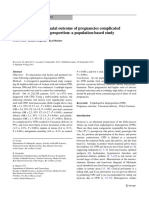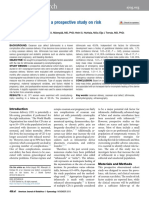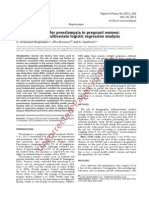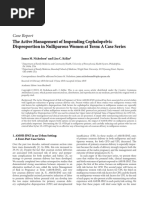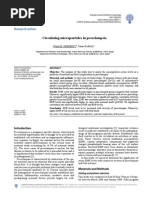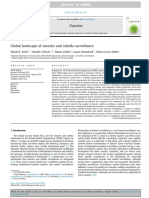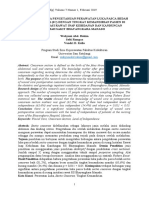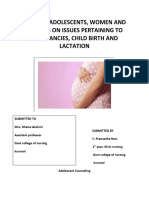Selected Pregnancy and Perinatal Outcomes of Patients With and Without A Previous Placenta Accrete
Selected Pregnancy and Perinatal Outcomes of Patients With and Without A Previous Placenta Accrete
Uploaded by
Muhammad IkbarCopyright:
Available Formats
Selected Pregnancy and Perinatal Outcomes of Patients With and Without A Previous Placenta Accrete
Selected Pregnancy and Perinatal Outcomes of Patients With and Without A Previous Placenta Accrete
Uploaded by
Muhammad IkbarOriginal Description:
Original Title
Copyright
Available Formats
Share this document
Did you find this document useful?
Is this content inappropriate?
Copyright:
Available Formats
Selected Pregnancy and Perinatal Outcomes of Patients With and Without A Previous Placenta Accrete
Selected Pregnancy and Perinatal Outcomes of Patients With and Without A Previous Placenta Accrete
Uploaded by
Muhammad IkbarCopyright:
Available Formats
www.AJOG.
org
Clinical Obstetrics, Epidemiology, Fetus, Medical-Surgical Complications, Neonatology, Physiology/Endocrinology, Prematurity
no differences in estimated fetal weight, birthweight, or gestational
age at delivery.
CONCLUSION: Unlike non-pregnant populations, sleep duration during pregnancy, when measured in the 3rd trimester, is not associated
with excessive GWG. This is likely due to altered physiology in pregnancy and additional factors contributing to sleep disruption. Additional data, especially sleep characteristics in the 1st and 2nd trimesters, is needed to further evaluate a possible association between sleep
duration and weight gain in pregnancy.
112 Is there a difference in the risk profile of women
who develop thrombo-embolic events in the
puerperium or later in life?
Maor Waldman1, Eyal Sheiner1, Ilana Shoham Vardi2
1
Soroka University Medical Center, Department of Obstetrics and
Gynecology, Beer-Sheva, Israel, 2Ben Gurion University of the Negev,
Department of Epidemiology and Health Services Evaluation, Beer-Sheva,
Israel
OBJECTIVE: Venous thrombo-embolic events (VTE) (mainly pulmonary embolism [PE] and deep vein thrombosis [DVT]) are currently
the primary cause for maternal death in the developed world. The
study objective was to identify whether risk factors for VTE during the
puerperium are different from these of thrombo-embolic events developed later in life during more than 10 years of follow-up.
STUDY DESIGN: A nested case-case study was designed, comparing
women who experienced VTE in the puerperium period to women
who experienced such an event over a period of a more than a decade.
The study included women (n316) with VTE from a cohort of
48,319 women that gave birth between the years 1987-1998 and had a
follow up period until 2011. Multiple logistic regression model was
constructed in order to define independent risk factors associated
with early (6 weeks) vs. late thrombo-embolic events.
RESULTS: VTE during puerperium occurred in 81 women, and in 235
within at least 10 years after the puerperium. Patients encountered
VTE during the puerperium had more PE events (n16, 19.8%) and
less DVT events (n42, 51.9%), compared with the late VTE group
(PE n15, 6.4%; DVT n159, 67.7%; p 0.001).
While baseline characteristics of the two VTE groups were similar
(table), women undergoing cesarean section (CS) in the delivery preceding the VTE were more likely to develop early VTE (OR1.8, 95%
Cl1.05-3.2, P0.032). Using a multivariate analysis, controlling for
confounders such as maternal age, CS was noted as an independent
risk factor for early vs. late VTE (adjusted OR1.9; 95% CI 1.1-3.5;
p0.023).
CONCLUSION: The risk profile of both earlier and late VTE are similar,
except for cesarean section which is an independent risk factor for
early (vs. late) VTE. Women encountered venous thrombo-embolic
event during the puerperium are more likely to suffer from pulmonary emboli than women encountering VTE after the puerperium.
Index pregnancy characteristics by
time of VTE occurrence
Poster Session I
113 Placenta accreta in a previous pregnancy
and its significance on subsequent births
Tamar Eshkoli1, Eyal Sheiner1, Adi Y Weintraub1,
Gershon Holcberg1, Fernanda Press1
1
Soroka University Medical Center, Ben-Gurion University of the Negev,
Obstetrics and Gynecology, Faculty of Health Sciences, Beer-Sheva, Israel
OBJECTIVE: To investigate the perinatal outcomes of women that had
a placenta accreta in a previous pregnancy.
STUDY DESIGN: We retrospectively compared all subsequent singleton
cesarean deliveries (CD) of women with a previous placenta accreta,
with CD of women with no such history, during the years 1988-2011.
RESULTS: Out of 34,567 singleton CD that occurred during the study
period, 0.1% (n30) were of women with a previous placenta accreta.
Recurrent placenta accreta occurred in 23.3% (7/30) of patients with
placenta accreta in their previous pregnancy. Previous placenta accreta was significantly associated with uterine rupture, peripartum
hysterectomy and the need for blood transfusions. Nevertheless, increased risk for adverse perinatal outcomes such as low Apgar scores at
5 minutes and perinatal mortality was not found in these patients
(table).
CONCLUSION: A pregnancy following a previous placenta accreta is at
increased risk for adverse maternal outcomes such as recurrent accreta, uterine rupture and peripartum hysterectomy. However, adverse perinatal outcomes are not demonstrated.
Selected pregnancy and perinatal outcomes
of patients with and without a
previous placenta accrete
Data are presented as percentages.
114 A proportion score of pelvic and neonatal head
circumference is highly predictive of instrumental delivery
and cesarean section due to cephalo-pelvic disproportion
Gadi Liberty1, Lina Linov2, Irena Sionov1, Alona Koval2, Bord
Ilia1, Eyal Anteby1
1
Barzilai Medical Center, Obstetrics and Gynecology, Ashkelon, Israel,
Barzilai Medical Center, Radiology, Ashkelon, Israel
OBJECTIVE: To evaluate the risk for instrumental delivery (ID) and
cesarean section due to cephalo-pelvic disproportion (CS-CPD), according to maternal pelvic CT parameters, and neonate weight and
head circumference.
STUDY DESIGN: We studied patients who delivered at term a singleton
fetus in vertex presentation, and had underwent an abdominal CT in
our institution. Pelvimetry was performed retrospectively. We analyzed the relation between maternal pelvic parameters, neonatal
weight and head circumference (HC), and the mode of delivery.
RESULTS: We enrolled 111 cases: 84 patients had NVD, 7 had ID and
20 had CS-CPD. The neonatal HC was significantly larger in ID and
CS-CPD in comparison to NVD (34.91.1, 34.92.5 and 33.81.7
cm, respectively, p0.03). The transverse diameter of the mid pelvis
was significantly smaller in ID and CS-CPD in comparison to NVD
(9.51.1, 9.80.9 and 10.40.8 cm respectively, p0.002). We expressed the composed A-P and lateral parameters of the pelvic inlet,
mid and outlet, with a naive formula of estimated ellipse circumference (EEC). The mid pelvic EEC was significantly smaller in ID and
CS-CPD in comparison to NVD (322.6, 33.53.5 and 34.82.3 cm
Supplement to JANUARY 2013 American Journal of Obstetrics & Gynecology
S61
Poster Session I
Clinical Obstetrics, Epidemiology, Fetus, Medical-Surgical Complications, Neonatology, Physiology/Endocrinology, Prematurity
respectively, p0.034). We used the ratio between the pelvic EEC and
HC to express a proportion score (PS) for CPD. The PS was significantly smaller in ID and CS-CPD, in comparison to NVD, in all pelvic
levels: inlet (1.080.1 and 1.090.1 VS 1.150.08, p0.006); mid
(0.920.09 and 0.970.1 VS 1.030.08, p0.0003); and outlet
(0.770.04 and 0.810.07 VS 0.840.08 p0.011). ROC analysis
showed that a mid pelvis PS of 1 had a 68% sensitivity, 58% specificity
and a positive predictive value of 89% for CS-CPD.
CONCLUSION: Low proportion score of maternal pelvic parameters and
neonate head circumference, is highly correlated with ID and CSCPD.
115 Placental abruption as a marker for long
term cardiovascular mortality: a follow up period
of more than a decade
Gali Pariente1, Ilana Shoham-Vardi2, Roy Kessous1, Eyal Sheiner1
1
Soroka University Medical Center, Department of Obstetrics and
Gynecology, Beer sheva, Israel, 2Soroka University Medical Center, Faculty of
Health Sciences, Beer sheva, Israel
OBJECTIVE: To investigate the risk for subsequent cardiovascular
events in women having placental abruption, during a follow-up period of more than 10 years.
STUDY DESIGN: A population-based study comparing consecutive
pregnancies of women with and without placental abruption was conducted. Deliveries occurred during the years 1988-1999 and had a
follow up until the year 2010. Associations between placental abruption and maternal long-term cardiovascular hospitalizations, morbidity and mortality were investigated. Multivariable analysis was
used to control for confounders.
RESULTS: During the study period, there were 47,909 deliveries who
met the inclusion criteria, of these 1.4% (n653) occurred in patients
with placental abruption. No significant differences were noted regarding subsequent long term hospitalizations due to cardiovascular
causes during at least a decade of follow-up (OR 1.2, 95% CI 0.8-1.8,
P0.314), as well as regarding invasive procedures (OR1.5 95% CI
0.7-3.3, P0.312; table). However, placental abruption was noted as a
risk factor for long term cardiovascular mortality (OR 6.6, 95% CI
2.3-18.4, P0.004). The case fatality rate for placental abruption was
13.0% vs. 2.5% in the comparison group. ( P0.001). In a multivariate logistic regression model, after controlling for confounders such
as ethnicity and maternal age, placental abruption was noted as an
independent risk factor for maternal long-term cardiovascular mortality (adjusted OR 4.5; 95% CI-1.1-19.1, P 0.041).
CONCLUSION: Placental abruption is a significant risk factor for longterm cardiovascular mortality in a follow-up period of more than a
decade.
Subsequent cardiovascular events in
women having placental abruption
116 Giving birth to a small for gestational age infant is a
risk factor for long-term maternal cardiovascular morbidity
Gali Pariente1, Roy Kessous1, Ilana Shoham-Vardi2, Eyal Sheiner1
1
Soroka University Medical Center, Ben-Gurion University of the Negev,
Department of Obstetrics and Gynecology, Beer-Sheva, Israel, 2Soroka
University Medical Center, Ben-Gurion University of the Negev, Faculty of
Health Sciences, Beer-Sheva, Israel
OBJECTIVE: To investigate whether women with a prior occurrence of
small-for-gestational-age (SGA) are at an increased risk for subsequent long term maternal cardiovascular morbidity.
S62
www.AJOG.org
STUDY DESIGN: A population-based study comparing consecutive
pregnancies of women with and without a previous delivery of a SGA
neonate was conducted. Deliveries occurred during the years 19881999, with a follow-up period until 2010. Incidence of long-term cardiovascular morbidity was compared between women with SGA neonate and women who gave birth at the same period to an appropriate
for gestational age neonate. Logistic regression was conducted to obtain adjusted odds ratios (AOR) and 95 % confidence intervals (CI)
for the association between SGA and subsequent cardiovascular
morbidity.
RESULTS: During the study period 47612 deliveries met the inclusion
criteria; 9.3% (n4411) occurred in patients with a prior occurrence
of SGA. Women with a prior occurrence of SGA had higher rates of
long term complex cardiovascular events such as congestive heart failure, cardiac arrest etc. (OR2.3; 95% CI 1.3-4.4, P0.006) and long
term cardiovascular mortality (OR 3.4; 95% CI 1.5-7.6, P0.006;
table). Using a multivariable logistic regression model, controlling for
confounders such as maternal age and ethnicity, having delivered a
SGA neonate was noted as an independent risk factor for long-term
maternal cardiovascular hospitalizations (AOR 1.4; 95% CI-1.11.6, P 0.001).
CONCLUSION: Delivery of a previous SGA infant is an important predictor of long-term maternal cardiovascular morbidity during a follow-up period of more than a decade.
Long term cardiovascular morbidity and
mortality in patients with and without a
prior occurrence of SGA
117 Misoprostol for treatment of intrauterine
fetal death at 14-28 weeks of pregnancy
Hillary Bracken1, Nguyen thi Nhu Ngoc2, Erika Banks3,
Paul Blumenthal4, Richard Derman5, Ashlesha Patel6,
Marji Gold7, Beverly Winikoff8
1
Gynuity Health Projects, New York, NY, 2Center for Research and
Consultancy in Reproductive Health (CRCRH), Ho Chi Minh City, Viet
Nam, 3Albert Einstein College of Medicine, Department of Obstetrics and
Gynecology, New York, NY, 4Stanford University, Family Planning Services
and Research, Palo Alto, CA, 5Christiana Care Hospital, Department of
Obstetrics and Gynecology, Newark, DE, 6JH Stroger Jr. Hospital of Cook
County, Department of Obstetrics and Gynecology, Chicago, IL, 7Albert
Einstein College of Medicine, Department of Family Medicine, New York,
NY, 8Gynuity Health Projects, New York, NY
OBJECTIVE: To systematically assess whether misoprostol has high
safety and effectiveness for the treatment of intrauterine fetal death at
14-28 weeks of pregnancy and to help establish the best dose of misoprostol for this purpose.
STUDY DESIGN: This double-blind trial randomized 153 women, 14-28
weeks gestation, into two groups. Women received either 100mcg
buccal misoprostol (Group 1) or 200 mcg buccal misoprostol (Group
2) every 6h for a maximum of 8 doses. The primary outcome was
successful evacuation within 48h.
RESULTS: The 200mcg dose was significantly more effective than the
100 mcg dose at evacuating the uterus within 48h (Group 1: 66.7%;
Group 2: 84.2% (RR 0.79 (95%CI: 0.65-0.95). The mean time to evacuation was significantly shorter in Group 2 (18.9h 11.9h) than
Group 1 (24.0 12.4h) (p0.03). The side effect profile was similar in
the two groups. Few women reported nausea (Group 1: 19%; Group 2:
24%), vomiting (Group 1: 10%; Group 2: 16%), chills (Group 1: 24%;
Group 2:21%) or headache (Group 1: 16%; Group 2: 21%). However,
significantly more women in the 200mcg group reported diarrhea
American Journal of Obstetrics & Gynecology Supplement to JANUARY 2013
You might also like
- Shaws Text Book of GynecologyDocument438 pagesShaws Text Book of GynecologySumeera Nirmal Samarakkody100% (6)
- The Unseen Side of Pregnancy: Non-Communicable Diseases and Maternal HealthDocument28 pagesThe Unseen Side of Pregnancy: Non-Communicable Diseases and Maternal HealthThe Wilson Center100% (2)
- Basic Biology of Sexual BehaviorDocument4 pagesBasic Biology of Sexual BehaviornegriRDNo ratings yet
- Fetal Station at Caesarean Section and Risk of SubDocument6 pagesFetal Station at Caesarean Section and Risk of Subggdsnzwbn7No ratings yet
- Case Report: The Active Management of Impending Cephalopelvic Disproportion in Nulliparous Women at Term: A Case SeriesDocument6 pagesCase Report: The Active Management of Impending Cephalopelvic Disproportion in Nulliparous Women at Term: A Case SeriesAnastasia FebriantiNo ratings yet
- Cephalopelvic Disproportion JournalDocument6 pagesCephalopelvic Disproportion JournalAdipta KurniawanNo ratings yet
- Risk Factors and Pregnancy Outcomes of Antepartum Hemorrhage in Women With Placenta PreviaDocument8 pagesRisk Factors and Pregnancy Outcomes of Antepartum Hemorrhage in Women With Placenta PreviaWilly AndreasNo ratings yet
- 1 s2.0 S0002937897802177 MainDocument1 page1 s2.0 S0002937897802177 MainPutri AgriNo ratings yet
- Placenta PreviaDocument5 pagesPlacenta PreviaKuro HanabusaNo ratings yet
- Vol93 No.6 661 5058Document6 pagesVol93 No.6 661 5058Titi Afrida SariNo ratings yet
- Cesarean Scar Defect: A Prospective Study On Risk Factors: GynecologyDocument8 pagesCesarean Scar Defect: A Prospective Study On Risk Factors: Gynecologynuphie_nuphNo ratings yet
- Fracture of The Clavicle in The Newborn Following Normal Labor and DeliveryDocument6 pagesFracture of The Clavicle in The Newborn Following Normal Labor and DeliveryAlberto OrtizNo ratings yet
- Obgyn 1Document4 pagesObgyn 1Auzia Tania UtamiNo ratings yet
- Predictive Factors For Preeclampsia in Pregnant Women: A Unvariate and Multivariate Logistic Regression AnalysisDocument5 pagesPredictive Factors For Preeclampsia in Pregnant Women: A Unvariate and Multivariate Logistic Regression AnalysisTiti Afrida SariNo ratings yet
- Kim 2006 Neonatal Outcome After Preterm Delivery in HELLPDocument6 pagesKim 2006 Neonatal Outcome After Preterm Delivery in HELLPMeta ParamitaNo ratings yet
- Am J Perinatol. 2007 Jun24 (6) 373-6Document4 pagesAm J Perinatol. 2007 Jun24 (6) 373-6Ivan Osorio RuizNo ratings yet
- Placental Abruption in Term and Preterm.8 PDFDocument8 pagesPlacental Abruption in Term and Preterm.8 PDFMuhammad Riza FahlawiNo ratings yet
- Original ArticleDocument5 pagesOriginal ArticledryNo ratings yet
- Predictors of Prognosis in Patients With Peripartum CardiomyopathyDocument2 pagesPredictors of Prognosis in Patients With Peripartum CardiomyopathyValentina GrajalesNo ratings yet
- Screening Utility of Umbilical Artery Doppler Indices in Patients With PreeclampsiaDocument6 pagesScreening Utility of Umbilical Artery Doppler Indices in Patients With PreeclampsiaAlhajiNo ratings yet
- Previous Preterm Cesarean Delivery and Risk of Uterine Rupturein Subsequent Trial of LaborDocument28 pagesPrevious Preterm Cesarean Delivery and Risk of Uterine Rupturein Subsequent Trial of LaborDjlatino LatinoNo ratings yet
- JP2010 708615Document5 pagesJP2010 708615Suci ArianiNo ratings yet
- Ductus Venous Doppler Waveform Pattern in Fetuses With Early Growth RestrictionDocument1 pageDuctus Venous Doppler Waveform Pattern in Fetuses With Early Growth RestrictionNestor FerrerNo ratings yet
- Circulating Microparticles in Preeclampsia: Research ArticleDocument4 pagesCirculating Microparticles in Preeclampsia: Research ArticleFahmi Nur ZamanNo ratings yet
- Intrapartum Fetal Monitoring PDFDocument4 pagesIntrapartum Fetal Monitoring PDFelda zulkarnainNo ratings yet
- 8 PGDocument8 pages8 PGNia wangiNo ratings yet
- European Journal of Obstetrics & Gynecology and Reproductive BiologyDocument5 pagesEuropean Journal of Obstetrics & Gynecology and Reproductive BiologyMikaNo ratings yet
- Correlation of Myometrial Thickness and The Latency Interval of Women With Preterm Premature Rupture of The MembranesDocument6 pagesCorrelation of Myometrial Thickness and The Latency Interval of Women With Preterm Premature Rupture of The MembranesstephaniedianNo ratings yet
- Pneumonia and Pregnancy Outcomes: A Nationwide Population-Based StudyDocument7 pagesPneumonia and Pregnancy Outcomes: A Nationwide Population-Based StudyAdrin Mahmuddin HarahapNo ratings yet
- Andrea Surányi, Ábel Altorjay, László Kaiser, Tibor Nyári, Gábor NémethDocument9 pagesAndrea Surányi, Ábel Altorjay, László Kaiser, Tibor Nyári, Gábor NémethfujimeisterNo ratings yet
- Ultrasound in Obstet Gyne - 2024 - Nguyen‐Hoang - Longitudinal evaluation of cervical length and shear wave elastographyDocument9 pagesUltrasound in Obstet Gyne - 2024 - Nguyen‐Hoang - Longitudinal evaluation of cervical length and shear wave elastographyibrahim2298No ratings yet
- Risk Factors For Umbilical Cord Prolapse at The Time of Arti Ficial Rupture of MembranesDocument6 pagesRisk Factors For Umbilical Cord Prolapse at The Time of Arti Ficial Rupture of MembranesElva Diany SyamsudinNo ratings yet
- Journal Pre-Proof: Journal of Pediatric and Adolescent GynecologyDocument18 pagesJournal Pre-Proof: Journal of Pediatric and Adolescent GynecologyCorey WoodsNo ratings yet
- Vol9 Issue1 06Document4 pagesVol9 Issue1 06annisaNo ratings yet
- Articles: BackgroundDocument13 pagesArticles: BackgroundHartanto LieNo ratings yet
- Doppler A UterinaDocument5 pagesDoppler A Uterinaclau2502No ratings yet
- Fetal Growth Velocity in Diabetics and The Risk For Shoulder Dystocia: A Case-Control StudyDocument6 pagesFetal Growth Velocity in Diabetics and The Risk For Shoulder Dystocia: A Case-Control Studyaulia ilmaNo ratings yet
- Association Maternal Age and TraumaDocument26 pagesAssociation Maternal Age and TraumaAinun RamadaniNo ratings yet
- Jurnal 1 MaterDocument4 pagesJurnal 1 MaterEvaliaRahmatPuzianNo ratings yet
- Clinical and Biomarkers Difference in Prepartum and Postpartum EclampsiaDocument10 pagesClinical and Biomarkers Difference in Prepartum and Postpartum EclampsiamerryNo ratings yet
- PDF Ijwhr 108Document4 pagesPDF Ijwhr 108Anonymous ApLSlrUNo ratings yet
- Nidhi Thesis PresentationDocument25 pagesNidhi Thesis Presentationujjwal souravNo ratings yet
- Hard Arson 2008Document7 pagesHard Arson 2008elda zulkarnainNo ratings yet
- Prolonged Second Stage of Labour, Maternal Infectious Disease, Urinary Retention and Other Complications in The Early Postpartum PeriodDocument9 pagesProlonged Second Stage of Labour, Maternal Infectious Disease, Urinary Retention and Other Complications in The Early Postpartum PeriodCordova ArridhoNo ratings yet
- Gestação e Apendicite Aguda - Apendicectomia Open Vs VL, Surgical Endoscopy, v.37, n.8, Aug. 2023.Document7 pagesGestação e Apendicite Aguda - Apendicectomia Open Vs VL, Surgical Endoscopy, v.37, n.8, Aug. 2023.Thiago FreireNo ratings yet
- Neurofibromatosis in PregnancyDocument3 pagesNeurofibromatosis in PregnancyAlexandrescu CatalinaNo ratings yet
- Articulo 5Document6 pagesArticulo 5Monica ReyesNo ratings yet
- Association of Biochemical Markers With The Severity of Pre EclampsiaDocument7 pagesAssociation of Biochemical Markers With The Severity of Pre EclampsiaFer OrnelasNo ratings yet
- Literature para Sa ThesisDocument56 pagesLiterature para Sa ThesisPeter AbellNo ratings yet
- 10.1111@aogs.13017Document20 pages10.1111@aogs.13017noneballroomvg14No ratings yet
- None 3Document7 pagesNone 3Sy Yessy ParamitaNo ratings yet
- Women's Health Care Physicians: Member Login Join Pay Dues Follow UsDocument24 pagesWomen's Health Care Physicians: Member Login Join Pay Dues Follow UsNazif Aiman IsmailNo ratings yet
- Gestational Age at Cervical Length Measurement and Incidence of Preterm BirthDocument7 pagesGestational Age at Cervical Length Measurement and Incidence of Preterm BirthSkruput QNo ratings yet
- Research Article: Pregnancy Outcome of Multiparous Women Aged Over 40 YearsDocument4 pagesResearch Article: Pregnancy Outcome of Multiparous Women Aged Over 40 YearsChristine Laurenza SNo ratings yet
- Fibroid Size and Number and Risk of Postpartum HemDocument2 pagesFibroid Size and Number and Risk of Postpartum Hemc6fj424ycrNo ratings yet
- Is Fetal Growth Restriction Associated With A More Severe Maternal Phenotype in The Setting of Early Onset Pre-Eclampsia? A Retrospective StudyDocument6 pagesIs Fetal Growth Restriction Associated With A More Severe Maternal Phenotype in The Setting of Early Onset Pre-Eclampsia? A Retrospective StudyYessie ErNo ratings yet
- Cervical Stitch Give Birth Kelompok 2Document78 pagesCervical Stitch Give Birth Kelompok 2Larose Rossyta SariNo ratings yet
- Research ArticleDocument7 pagesResearch ArticlesyahputriNo ratings yet
- RJMS - Article 6 - Veeresh S A - July 2021 - 11 (3) - 160-164Document5 pagesRJMS - Article 6 - Veeresh S A - July 2021 - 11 (3) - 160-164Shah NAWAZNo ratings yet
- The Influence of Pregnancy, Parity, and Mode of deDocument13 pagesThe Influence of Pregnancy, Parity, and Mode of deadeNo ratings yet
- Short Stature Is Associated With An Increased Risk of Caesarean Deliveries in Low Risk PopulationDocument6 pagesShort Stature Is Associated With An Increased Risk of Caesarean Deliveries in Low Risk PopulationManangioma ManNo ratings yet
- Lower Genital Tract Precancer: Colposcopy, Pathology and TreatmentFrom EverandLower Genital Tract Precancer: Colposcopy, Pathology and TreatmentNo ratings yet
- Absolute Obstetric Anesthesia Review: The Complete Study Guide for Certification and RecertificationFrom EverandAbsolute Obstetric Anesthesia Review: The Complete Study Guide for Certification and RecertificationNo ratings yet
- Bacterial Peritonitis in A Patient With Malignant Ascites Caused by Pancreatic Carcinoma - Case Report and Review of LiteratureDocument4 pagesBacterial Peritonitis in A Patient With Malignant Ascites Caused by Pancreatic Carcinoma - Case Report and Review of LiteratureMuhammad IkbarNo ratings yet
- Global Landscape of Measles and Rubella SurveillanceDocument8 pagesGlobal Landscape of Measles and Rubella SurveillanceMuhammad IkbarNo ratings yet
- Risk Factors, Early and Late Postpartum Complications of Retained Placenta - A Case Control StudyDocument6 pagesRisk Factors, Early and Late Postpartum Complications of Retained Placenta - A Case Control StudyMuhammad IkbarNo ratings yet
- Surgical Treatment of Trigeminal NeuralgiaDocument10 pagesSurgical Treatment of Trigeminal NeuralgiaMuhammad IkbarNo ratings yet
- Chapter 10 - Trigeminal NeuralgiaDocument5 pagesChapter 10 - Trigeminal NeuralgiaMuhammad IkbarNo ratings yet
- 20 Hard-Knock Life Lessons From Orgasmic Meditation.: Candice HoldorfDocument6 pages20 Hard-Knock Life Lessons From Orgasmic Meditation.: Candice HoldorfGeorgianna StrungaruNo ratings yet
- Gender Roles Sa Africa at Kanlurang AsyaDocument28 pagesGender Roles Sa Africa at Kanlurang AsyaRica67% (6)
- Finals MCCCCNDocument70 pagesFinals MCCCCNNaomi Anne AsuntoNo ratings yet
- Ob Safe Sex PresentationDocument37 pagesOb Safe Sex Presentationluckyswiss7776848No ratings yet
- Obstetric Outpatient: Friday, April 20 2018Document14 pagesObstetric Outpatient: Friday, April 20 2018Riyan W. PratamaNo ratings yet
- Maternal Mortality Rates Report For 2022Document5 pagesMaternal Mortality Rates Report For 2022ABC Action NewsNo ratings yet
- Stages of Labor ADocument14 pagesStages of Labor AMaria Angela Viray100% (1)
- Healthy Timing and Spacing of Pregnancy (HTSP)Document5 pagesHealthy Timing and Spacing of Pregnancy (HTSP)mnmrznNo ratings yet
- Homosexuality Sociology Hekma2016Document8 pagesHomosexuality Sociology Hekma2016thanhvuk09No ratings yet
- Sectio Caesarea (SC) Dengan Tingkat Kemandirian Pasien DiDocument8 pagesSectio Caesarea (SC) Dengan Tingkat Kemandirian Pasien DiWindi SugiantiNo ratings yet
- Biology 2 Lecture 10 - Reproductive SystemDocument42 pagesBiology 2 Lecture 10 - Reproductive SystemRYLE IBANEZNo ratings yet
- Feminist Perspectives On Sex Markets Debate Mackinnon Dworkin Longino EtcDocument33 pagesFeminist Perspectives On Sex Markets Debate Mackinnon Dworkin Longino EtcLucia NigroNo ratings yet
- Retained Placenta ManagementDocument4 pagesRetained Placenta ManagementDevanty AnggrainiNo ratings yet
- ART Review Interim ReportDocument168 pagesART Review Interim ReportJill HennessyNo ratings yet
- Tugas Individu B.inggris (Midwifery Care)Document11 pagesTugas Individu B.inggris (Midwifery Care)irmanurulNo ratings yet
- Bahasa Inggris NURHALIMAH-1Document3 pagesBahasa Inggris NURHALIMAH-1NurhalimahNo ratings yet
- Limitation and DefinitionDocument4 pagesLimitation and DefinitionROSE SARTINNo ratings yet
- Lesson 2:: The Family Today: Declining or Changing?Document73 pagesLesson 2:: The Family Today: Declining or Changing?Rovien VivasNo ratings yet
- Midwifery KitDocument3 pagesMidwifery KitRitzel CreusNo ratings yet
- Counsel Adolescents, Women and Families On Issues Pertaining To Pregnancies, Child Birth and LactationDocument14 pagesCounsel Adolescents, Women and Families On Issues Pertaining To Pregnancies, Child Birth and LactationSirisha ChelvaNo ratings yet
- Menopause: By: DR Jay M.DDocument12 pagesMenopause: By: DR Jay M.DHarinesh JayNo ratings yet
- Premature Rupture of MembraneDocument7 pagesPremature Rupture of MembranedrommygreatNo ratings yet
- ICFP Youth Advocacy Briefing NoteDocument13 pagesICFP Youth Advocacy Briefing NoteKristen NallanNo ratings yet
- Preterm LaborDocument10 pagesPreterm Laborfathima AlfasNo ratings yet
- 2020 World AIDS Day Report Graphs Tables enDocument45 pages2020 World AIDS Day Report Graphs Tables enRizka Ayu SetyaniNo ratings yet
- Sample Nursing QuestionsDocument4 pagesSample Nursing QuestionsZhy CaluzaNo ratings yet
- Jurnal ReadingDocument13 pagesJurnal Readingmeyke potutuNo ratings yet





